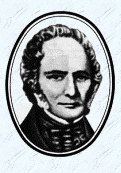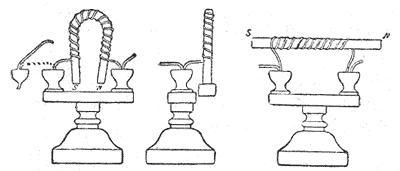William Stёrdzhen and the world's first electro-magnet
 Stёrdzhen (Sturgeon) William (22/05/1783, Uaytington, near the city of Lancaster - 04.12.1850, Prestwich, near Manchester), English inventor in the field of electrical engineering. Special education is not received. In 1825, he invented the electromagnet in 1830 developed the manufacture of plates of amalgamated zinc technology for electrochemical cells. Constructed galvanometer moving coil (1836). He conducted studies of atmospheric electricity, and worked on the lightning protection. In 1836 he founded the first British Electrotechnical Journal "Annals of Electricity".
Stёrdzhen (Sturgeon) William (22/05/1783, Uaytington, near the city of Lancaster - 04.12.1850, Prestwich, near Manchester), English inventor in the field of electrical engineering. Special education is not received. In 1825, he invented the electromagnet in 1830 developed the manufacture of plates of amalgamated zinc technology for electrochemical cells. Constructed galvanometer moving coil (1836). He conducted studies of atmospheric electricity, and worked on the lightning protection. In 1836 he founded the first British Electrotechnical Journal "Annals of Electricity".
Following the publication of a pamphlet Oersted many interested in the problems of electromagnetism: in the same 1820 Arago demonstrated a wire with a current, plastered with iron filings, and Ampère proved that spiral current - solenoid - has all the properties of natural magnet, attracting small iron objects.
As to the first electromagnet, ie coil current and streamlined contained within the iron core, his invention had to wait another five years. This device is made by William Sturgeon.
He was born in Lancaster in 1783 in the family of a shoemaker. Father of the family did not pay the slightest attention; He enjoyed life, was fishing and had the reputation of a great lover of cockfights. Young William was sent to learn the skill of the shoemaker, who, apparently, kept him in a black body. William was starving, so as soon as the chance to have escaped from a cobbler in a military unit. It was then nineteen. Two years later, William was promoted to the gunner, he read a lot, put the physical and chemical experiments.
Once, when they were standing on the part of the island of Newfoundland, he ran terrible hurricane, accompanied by lightning and thunder. The hurricane produced a William unexpectedly impressed and drew his attention to electricity. He began to read books on the natural sciences, but soon realized bitterly that nothing they do not understand. Then he decided to start with the basics and started writing, reading and grammar. Sergeant same parts supplied him with books that William, freed from the watch, read at night. He soon moved on to mathematics, dead and modern languages, natural sciences, and optics. His passion in his spare time was to repair the clock and draw.
After his release from military service in 1820 Sturgeon bought a lathe and devoted himself to the production of physical devices, such as electric. With the support of the then-known chemist James Marsh, he was appointed lecturer at the Military Academy of the East India Company in Addiscombe, where he taught until 1838
The first contribution of Sturgeon in science was the development of their modified model of rotating cylinders Ampere described in the "Journal of Philosophy" in 1823. The following year, he wrote four articles on thermoelectricity, and May 23, 1825 the Company introduced the arts more advanced devices for electromagnetic experiments among them was who is now famous first electromagnet. The idea of a cylindrical and horseshoe magnets grabbed it even in 1823. Then Sturgeon and built a rotating "wheel Sturgeon '- in fact, one of the first modifications of the electric motor.
Sturgeon has made some very important discoveries, which wrote a few articles, but the "Philosophical Magazine", for which they were intended, refused to print them, and Sturgeon had no how to create your own magazine - "Annals of electricity."
Science Museum in Manchester, whose director became Sturgeon in 1840, was too scientific to be profitable, and Sturgeon lived in poverty. In 1850, the inventor of the electromagnet died without receiving a reward for his great invention neither wealth nor fame.
Trainee Sturge, the famous English physicist James Prescott Joule, wrote that Sturgeon was tall and well built, possessed a noble appearance and pleasant manners. Unfortunately, his portrait has been preserved. On his tombstone is engraved: "Here lies the inventor of electromagnet ..."

The first electromagnet world demonstrated Sturgeon May 23, 1825 Society of Arts, was a bent into a horseshoe painted iron rod length 30 and a diameter of 1.3 cm, topped with a layer of insulated copper wire. It supplies electricity from a galvanic battery (voltaic pile). The electromagnet is held at 3600 g weight and far superior to the power of natural magnets of the same mass. It was a brilliant achievement for the time.
Sam Sturgeon particularly appreciated the idea associated with the replacement of the hard iron soft. The scientist is free to operate with such concepts as "magnetism", "magnetic energy", "uniformity of magnetic material", "joke of iron," etc.
Board of Governors assessed contribution Sturgeon. He received a medal and a cash prize, and the first electromagnet was exhibited in the museum community.
Joel, experimenting with the first magnet Sturgeon, was able to bring it to lift 20 kg. It was the same in 1825
In 1828, a London watchmaker Watkins made the electromagnet, which lifted 30 kg.
At the same time, Professor Mall of Utrecht, based on the design of Watkins, produced a magnet, "raises the anvil weighing 60 kg or lift an anvil weighing 80 kg."
In 1832, Sturgeon made the magnet lifts 160 kg, but in March the same year created a magnet that can lift more than 200 kg. However, Sturgeon was not going to lose the championship. In his order in 1840 he was made an electromagnet that can lift 550 kg already!
By that time, Sturgeon found a very strong contender for the ocean. In April 1831 Yale University professor Joseph Henry (named after his unit of inductance) built an electromagnet weighing about 300 kg, rises about 1 m.
All these magnets by design is a horseshoe-shaped rods wrapped with wire. Joule in November 1840, he set up a private magnet structure in a thick steel tube, cut along the axis. The cross section of the magnet was very large, the magnet turned out compact and raised 1.3 T. At the same time Joel has built a completely new design magnet - attracted by the goods had no effect of the two poles, as usual, and much more, which allowed to increase sharply lift loads . Magnet weight 5.5kg held a weight of 1.2 tonnes.
The first magnets were made "as the spirit lay." However, any form of give good results. By chance it so happened that Sturgeon for his first magnet is very well chosen - a horseshoe - shape (horseshoe-shaped magnets are made up to now). Lack of experience and basic methods of calculating magnets led to the fact that some types of magnets, proposed at the time, would be, in our opinion, is simply absurd. So, trehlapy magnet could not work successfully since the magnetic fluxes of each rod to counteract each other - the flow of rod closes on the second bar, where he acted upstream of the rod.
Unfit for a modern look, and is very common to use a construction, in which a magnet is made up of three smaller and wound separately. It is clear that in the intervals between these small magnets, magnetic fields of the two neighboring rods are mutually destroyed.
Laboratory magnets that period were made "by eye". There is no theory that would allow to predict the properties of magnets did not exist. The first contribution to the theory of calculating the electromagnets have Russian scientists E.X. Lenz and BS Jacobi pointed out the connection of lift of the electromagnet and the product of the current in the coils of the number of winding turns.
After Lenz and Jacobi major contribution to the theory of magnets calculation made by the British Hopkinson brothers, who proposed a method of saturation of accounting - the phenomenon of long sighted magnets designers lies in the fact that the magnet is a predetermined shape after a certain limit increasing current in the coils can not increase its lift. Modern theory attributes this phenomenon is that when a certain magnetizing current elementary magnets (dipoles) iron (ferromagnetic) previously arranged randomly, mainly oriented in one direction and the further strengthening of the magnetizing current substantially increasing the number of magnets oriented in the same direction, not happening. Saturation of steel has led to the fact that the magnetic field of the first magnet does not exceed T 2.
There was a new era of power amplification magnets, but not by increasing their size, and by improving their shape and fight to the saturation. We can not say that this struggle has been very successful. Over a hundred years of intense war of physicists with unruly "saturating" steel induction of the magnetic field in the magnets has increased only two and a half times. Above this problem worked many prominent physicists and electrical engineers.


Comments
Commenting, keep in mind that the content and the tone of your messages can hurt the feelings of real people, show respect and tolerance to his interlocutors, even if you do not share their opinion, your behavior in terms of freedom of speech and anonymity offered by the Internet, is changing not only virtual, but real world. All comments are hidden from the index, spam control.